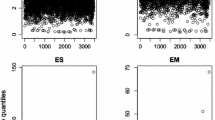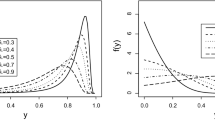Abstract
This paper develops a simple and computationally efficient parametric approach to the estimation of general hidden Markov models (HMMs). For non-Gaussian HMMs, the computation of the maximum likelihood estimator (MLE) involves a high-dimensional integral that has no analytical solution and can be difficult to approach accurately. We develop a new alternative method based on the theory of estimating functions and a deconvolution strategy. Our procedure requires the same assumptions as the MLE and deconvolution estimators. We provide theoretical guarantees about the performance of the resulting estimator; its consistency and asymptotic normality are established. This leads to the construction of confidence intervals. Monte Carlo experiments are investigated and compared with the MLE. Finally, we illustrate our approach using real data for ex-ante interest rate forecasts.









Similar content being viewed by others
Notes
We refer the reader to Doukhan (1994) for the proof that if \((X_i)_i\) is an ergodic process then the process \((Y_i)_i\), which is the sum of an ergodic process with an i.i.d. noise, is again stationary ergodic. Moreover, by the definition of an ergodic process, if \((Y_i)_i\) is an ergodic process then the couple \(\mathbf {Y}_i=(Y_i, Y_{i+1})\) inherits the property (see Genon-Catalot et al. (2000)).
We argue that our approach can be applied when we introduce a long mean parameter \(\mu \) in the volatility process.
References
Andrieu C, Doucet A, Holenstein R (2010) Particle Markov chain Monte Carlo methods. J R Stat Soc B 72(3):269–342
Bos CS, Shephard N (2006) Inference for adaptive time series models: stochastic volatility and conditionally gaussian state space form. Econom Rev 25(2–3):219–244
Brunel E, Comte F, Lacour C (2007) Adaptive estimation of the conditional density in the presence of censoring. Sankhyā 69:734–763
Burmeister E, Wall KD (1982) Kalman filtering estimation of unobserved rational expectations with an application to the german hyperinflation. J Econom 20(2):255–284
Burmeister E, Wall KD, Hamilton JD (1986) Estimation of unobserved expected monthly inflation using kalman filtering. J Bus Econ Stat 4(2):147–160
Butucea C, Matias C (2005) Minimax estimation of the noise level and of the deconvolution density in a semiparametric convolution model. Bernoulli 11(2):309–340
Chan JC (2017) The stochastic volatility in mean model with time-varying parameters: an application to inflation modeling. J Bus Econ Stat 35(1):17–28
Chanda KC (1995) Large sample analysis of autoregressive moving-average models with errors in variables. J Time Ser Anal 16(1):1–15
Chopin N, Jacob PE, Papaspiliopoulos O (2013) Smc2: an efficient algorithm for sequential analysis of state space models. J R Stat Soc B 75(3):397–426
Comte F, Taupin M-L (2001) Semiparametric estimation in the (auto)-regressive \(\beta \)-mixing model with errors-in-variables. Math Methods Stat 10(2):121–160
Costa M, Alpuim T (2010) Parameter estimation of state space models for univariate observations. J Stat Plann Inference 140(7):1889–1902
Dedecker J, Samson A, Taupin M-L (2014) Estimation in autoregressive model with measurement error. ESAIM Prob Stat 18:277–307
Delaigle A, Hall P (2016) Methodology for non-parametric deconvolution when the error distribution is unknown. J R Stat Soc B 231–252
Delyon B, Lavielle M, Moulines E (1999) Convergence of a stochastic approximation version of the em algorithm. Ann Stat 94–128
Douc R, Moulines E, Olsson J, van Handel R (2011) Consistency of the maximum likelihood estimator for general hidden Markov models. Ann Stat 39(1):474–513
Doucet A, De Freitas N, Gordon N (2001) An introduction to sequential monte carlo methods. In: Sequential Monte Carlo methods in practice, pp 3–14. Springer
Doukhan P (1994) Mixing. Properties and examples, volume 85 of Lecture notes in statistics. Springer, New York
Ebner B, Klar B, Meintanis SG (2018) Fourier inference for stochastic volatility models with heavy-tailed innovations. Stat Pap 59(3):1043–1060
Efromovich S (1997) Density estimation for the case of supersmooth measurement error. J Am Stat Assoc 92(438):526–535
El Kolei S (2013) Parametric estimation of hidden stochastic model by contrast minimization and deconvolution. Metrika 76(8):1031–1081
El Kolei S, Patras F (2018) Analysis, detection and correction of misspecified discrete time state space models. J Comput Appl Math 333:200–214
El Kolei S, Pelgrin F (2017) Parametric inference of autoregressive heteroscedastic models with errors in variables. Stat Probab Lett 130:63–70
Fan J, Truong YK, Wang Y (1991) Nonparametric function estimation involving errors-in-variables. In: Nonparametric functional estimation and related topics, pp 613–627. Springer
Fan G-L, Liang H-Y, Wang J-F (2013) Empirical likelihood for heteroscedastic partially linear errors-in-variables model with \(\alpha \)-mixing errors. Stat Pap 54(1):85–112
Genon-Catalot V, Jeantheau T, Larédo C (2000) Stochastic volatility models as hidden Markov models and statistical applications. Bernoulli 6(6):1051–1079
Ghysels E, Harvey AC, Renault E (1996) Stochastic volatility. Handb Stat 14:119–191
Hamilton JD (1994a) State-space models. Handb Econ 4:3039–3080
Hamilton JD (1994b) Time series analysis, vol 2. Princeton University Press, Princeton
Hannan EJ, Rissanen J (1982) Recursive estimation of mixed autoregressive-moving average order. Biometrika 69(1):81–94
Hayashi F (2000) Econometrics. Princeton University Press, Princeton
Holston K, Laubach T, Williams JC (2017) Measuring the natural rate of interest: international trends and determinants. J Int Econ 108:S59–S75
Jones GL (2004) On the Markov chain central limit theorem. Probab Surv 1:299–320
Kappus J, Mabon G (2014) Adaptive density estimation in deconvolution problems with unknown error distribution. Electron J Stat 8(2):2879–2904
Lacour C (2007) Adaptive estimation of the transition density of a markov chain. Annales de l’IHP Probabilités et statistiques 43:571–597
Lacour C (2008a) Adaptive estimation of the transition density of a particular hidden markov chain. J Multivar Anal 99(5):787–814
Lacour C (2008b) Least squares type estimation of the transition density of a particular hidden Markov chain. Electron J Stat 2:1–39
Lacour C (2008c) Nonparametric estimation of the stationary density and the transition density of a markov chain. Stoch Process Appl 118(2):232–260
Laubach T, Williams JC (2003) Measuring the natural rate of interest. Rev Econ Stat 85(4):1063–1070
Lilliefors HW (1967) On the kolmogorov-smirnov test for normality with mean and variance unknown. J Am Stat Assoc 62(318):399–402
Lindsten F (2013) An efficient stochastic approximation EM algorithm using conditional particle filters. In: 2013 IEEE international conference on acoustics, speech and signal processing, pp 6274–6278. IEEE
Meister A (2004) On the effect of misspecifying the error density in a deconvolution problem. Can J Stat 32(4):439–449
Miao Y, Zhao F, Wang K, Chen Y (2013) Asymptotic normality and strong consistency of LS estimators in the EV regression model with NA errors. Stat Pap 54(1):193–206
Mokkadem A et al (1987) Sur un modèle autorégressif non linéaire, ergodicité et ergodicité géométrique. J Time Ser Anal 8(2):195–204
Neumann MH, Hössjer O (1997) On the effect of estimating the error density in nonparametric deconvolution. J Nonparametric Stat 7(4):307–330
Newey WK, McFadden D (1994a) Large sample estimation and hypothesis testing. In: Handbook of econometrics, Vol. IV, volume 2 of Handbooks in econom., pp 2111–2245. North-Holland, Amsterdam
Newey WK, McFadden D (1994b) Large sample estimation and hypothesis testing. Handb Econ 4:2111–2245
Olsson J, Rydén T (2007) Particle filter-based approximate maximum likelihood inference asymptotics in state-space models. In: Conference Oxford sur les méthodes de Monte Carlo séquentielles, volume 19 of ESAIM Proc., pp 115–120. EDP Sci., Les Ulis
Omori Y, Chib S, Shephard N, Nakajima J (2007) Stochastic volatility with leverage: fast and efficient likelihood inference. J Econom 140(2):425–449
Pivetta F, Reis R (2007) The persistence of inflation in the united states. J Econ Dyn Control 31(4):1326–1358
Staudenmayer J, Buonaccorsi JP (2005) Measurement error in linear autoregressive models. J Am Stat Assoc 100(471):841–852
Stock JH, Watson MW (2007) Why has us inflation become harder to forecast? J Money Credit Bank 39:3–33
Taylor S (2005) Financial returns modelled by the product of two stochastic processes, a study of daily sugar prices, vol 1. Oxford University Press, Oxford, pp 203–226
Trapletti A, Hornik K (2019) tseries: time series analysis and computational finance. R package version 0.10-47
Van der Vaart AW (1998) Asymptotic statistics, vol 3. Cambridge series in statistical and probabilistic mathematics. Cambridge University Press, Cambridge
Zhou H, You J, Zhou B (2010) Statistical inference for fixed-effects partially linear regression models with errors in variables. Stat Pap 51(3):629–650
Author information
Authors and Affiliations
Corresponding author
Additional information
Publisher's Note
Springer Nature remains neutral with regard to jurisdictional claims in published maps and institutional affiliations.
Rights and permissions
About this article
Cite this article
Chesneau, C., El Kolei, S. & Navarro, F. Parametric estimation of hidden Markov models by least squares type estimation and deconvolution. Stat Papers 63, 1615–1648 (2022). https://doi.org/10.1007/s00362-022-01288-x
Received:
Revised:
Accepted:
Published:
Issue Date:
DOI: https://doi.org/10.1007/s00362-022-01288-x




